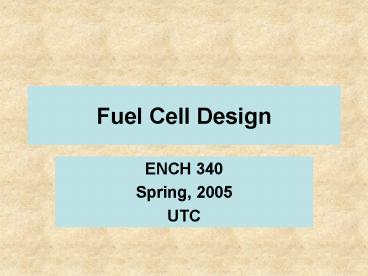Fuel Cell Design - PowerPoint PPT Presentation
1 / 13
Title:
Fuel Cell Design
Description:
Ceramic processing and challenges in the design and manufacturing process of SOFCs will be addressed . The amount of hydrogen that the unit produces may be ... – PowerPoint PPT presentation
Number of Views:76
Avg rating:3.0/5.0
Title: Fuel Cell Design
1
Fuel Cell Design
- ENCH 340
- Spring, 2005
- UTC
2
Technical and EconomicAspects of a 25 kW Fuel
Cell
- Chris Boudreaux
- Jim Henry, P.E.
- Wayne Johnson
- Nick Reinhardt
3
Technical and EconomicAspects of a 25 kW Fuel
Cell
- Chemical and Thermodynamic Aspects
- Investigate the design of
- --a 25 kW Fuel Cell
- --Coproduce Hydrogen
- --Grid parallel
- --Solid Oxide Electrolyte
Our Capabilities
4
Outline
- Introduction to the project
- Flowsheet Development
- Equipment Design
- Economics
5
Introduction
- Overall Reaction
- Methane Air --gt Electricity
- Hydrogen
Heat
6
Introduction
Gas
Reformer
Air
SynGas
Electricity
Fuel Cell
Heat
POC
Pressure Swing Absorption
Hydrogen
7
Fuel Cell-Chemistry
SynGas
POC
H2
H2
CO
H2O
CO2
CO
O
O
Air
Air
O2 N2
Solid Oxide Electrolyte Is porous to O
8
Fuel Cell-Electricity
SynGas
POC
H2
H2O
CO2
CO
Load
O
O
Air
Air
O2 N2
Electrons
9
Fuel Cell-Challenges
SynGas
POC
H2
Hot SynGas
H2
CO
H2O
CO2
CO
Recover H2
O
O
Air
Air
O2 N2
Hot Air
Recover Heat
10
Flowsheet Development
11
Equipment Design
12
Economics
13
Fuel Cell
Heat
. Objective Develop and demonstrate a 25 kW, grid
parallel, solid oxide fuel cell system that
coproduces hydrogen. , the installation be
configured to simultaneously and efficiently
produce hydrogen from a commercial natural gas
feedstream in addition to electricity. This
ability to produce both hydrogen and electricity
at the point of use provides an early and
economical pathway to hydrogen production. .
Ceramic processing and challenges in the design
and manufacturing process of SOFCs will be
addressed . The amount of hydrogen that the
unit produces may be controlled by the adjusting
the natural gas flow at steady power production
(i.e., adjusting the fuel utilization). A nominal
production rate of 25 kg of hydrogen per day
falls within the expected upper and lower
utilization limits for 25 kW electricity
production. The system produces a hydrogen-rich
exhaust stream that will be purified using a
Pressure Swing Absorption (PSA) unit. The
hydrogen flow and purity are interdependent. It
is expected that purity gt98 is achievable for
flows of 2-3 kg/day. Critical impurities, such as
CO and CO2 will be measured. It is not clear
that this size system makes sense for commercial
production. We are looking at a 25 kW module as a
building block for commercial production to begin
in 2006. The size of the 25 kW module is
estimated to be smaller than a 5 ft cube. The
cost of early commercial systems is expected to
be lt10K/kW































